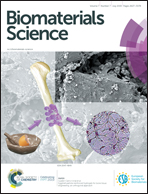Hybridization of a phospholipid polymer hydrogel with a natural extracellular matrix using active cell immobilization†
Abstract
Three-dimensional tissue organization is still an obstacle in the field of tissue engineering, which generally involves cell immobilization, proliferation, and organization. As an artificial extracellular matrix (ECM) for providing a suitable environment of cells to construct tissues, combination of cytocompatible polymer hydrogels and natural ECM produced by the immobilized cells was considered. In this research, we designed a spontaneously forming hydrogel system between two water-soluble polymers for the immobilization of cells. These polymers were poly(2-methacryloyloxyethyl phosphorylcholine-co-n-butyl methacrylate-co-p-vinylphenylboronic acid-co-N-succinimidyloxycarbonyl tetra(ethylene glycol)methacrylate) (PMBVS) and poly(vinyl alcohol) (PVA) to form a PMBVS/PVA hydrogel in a cell culture medium under mild conditions. Basic fibroblast growth factor (bFGF) was conjugated with PMBVS (PMBV–bFGF). To enhance the growth of the immobilized cells, mouse fibroblast L929 cells were immobilized in the PMBVS/PVA hydrogel and the PMBV–bFGF/PVA hydrogel, and their proliferation and secretion of the ECM under stimulation with bFGF was observed. The ECM infiltrated and replaced the hydrogel, resulting in the formation of a hybrid hydrogel with the ECM and laden cells.



 Please wait while we load your content...
Please wait while we load your content...